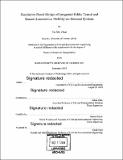Simulation-based design of integrated public transit and shared autonomous mobility-on-demand systems
Author(s)
Chen, Yu Xin (Yu Xin Leo)
DownloadFull printable version (8.469Mb)
Other Contributors
Massachusetts Institute of Technology. Department of Civil and Environmental Engineering.
Advisor
Jinhua Zhao and Neema Nassir.
Terms of use
Metadata
Show full item recordAbstract
The autonomous vehicle (AV) is poised to be one of the most disruptive technologies in the transportation industry. The advent of three major trends in transportation: automation, on-demand mobility and ride-sharing, are set to revolutionize the way we travel. The forthcoming adoption and commercialization of AVs are expected to have extensive impacts on our road networks, congestion, safety, land use, public transportation (PT) and more. Rapid advances in AV technology are convincing many that AV services will play a significant role in future transportation systems. The advancement of AVs presents both opportunities and threats to transportation. It has the potential to significantly impact traffic congestion, traffic accidents, parking and VMT (vehicle miles traveled), especially for people that are not able to drive such as children and elderly people. Motivated by the potential of autonomous vehicles, authorities around the world are preparing for this revolution in transport and deems this an important research direction that requires significant investigation. This thesis tackled and contributed to three main research questions related to the impact of autonomous vehicles on transportation systems. First, this thesis proposes a simulation-based approach to the design and evaluation of integrated autonomous vehicle and public transportation systems. We highlight the transit-orientation by respecting the social-purpose considerations of transit agencies (such as maintaining service availability and ensuring equity) and identifying the synergistic opportunities between AV and PT. Specifically, we identified that AV has a strong potential to serve first-mile connections to the PT stations and provide efficient and affordable shared mobility in low-density suburban areas that are typically inefficient to serve by conventional fixed-route PT services. The design decisions reflect the interest of multiple stakeholders in the system. Second, the interaction between travelers (demand) and operators (supply) is modeled using a system of equations that is solved as a fixed-point problem through an iterative procedure. In this, we developed demand and supply as two sub-problems. The demand will be predicted using a nested logit model to estimate the volume for different modes based on modal attributes. The supply will use a simulation platform capable of incorporating critical operational decisions on factors including fleet sizes, vehicle capacities, sharing policies, fare schemes and hailing strategies such as in-advance and on-demand requests. Using feedback between demand and supply, we enable interactions between the decisions of the service operator and those of the travelers, in order to model the choices of both parties. Finally, this thesis systematically optimizes service design variables to determine the best outcome in accordance to AV+PT stakeholder goals. Optimization objective functions can be formulated to reflect the different objectives of different stakeholders. In this paper, we specifically propose and develop a simulation-based service design method where we quantify various benefits and costs to reflect the objectives of key AV+PT stakeholders. We simulate the service with different sets of system settings and identify the highest performing set. We employ a case study of regional service contracting to showcase the ability of this method to inform AV+PT service design. We tested our approach with a case study area in a major European city on an agent-based simulation platform, amod-abm. Agent-based simulation has the advantage of capturing individual (agent) behaviors and the interactions of the various individual agents in a realistic synthetic environment where the intent is to re-create a complex phenomenon of mobility on demand service delivered by AV. Although this thesis will focus on a major European city, the general framework and methodologies proposed here can be widely applicable. The thesis concludes that the demand-supply interaction can be effective for designing and assessing the role of AV technology in our mobility systems. Moreover, simulation-based optimization can be an effective method for transit agencies to make decisions that support their overall AV related transport strategy as well as operational planning.
Description
Thesis: S.M. in Transportation, Massachusetts Institute of Technology, Department of Civil and Environmental Engineering, 2018. Cataloged from PDF version of thesis. Includes bibliographical references (pages 89-95).
Date issued
2018Department
Massachusetts Institute of Technology. Department of Civil and Environmental EngineeringPublisher
Massachusetts Institute of Technology
Keywords
Civil and Environmental Engineering.